Blooming Nakanishi
The company handles manufacturing for the printed covers in the Hobonichi Techo cover lineup. The factory we visited this time makes the Mother 2, Ryoji Arai, and Antique Handkerchief covers.
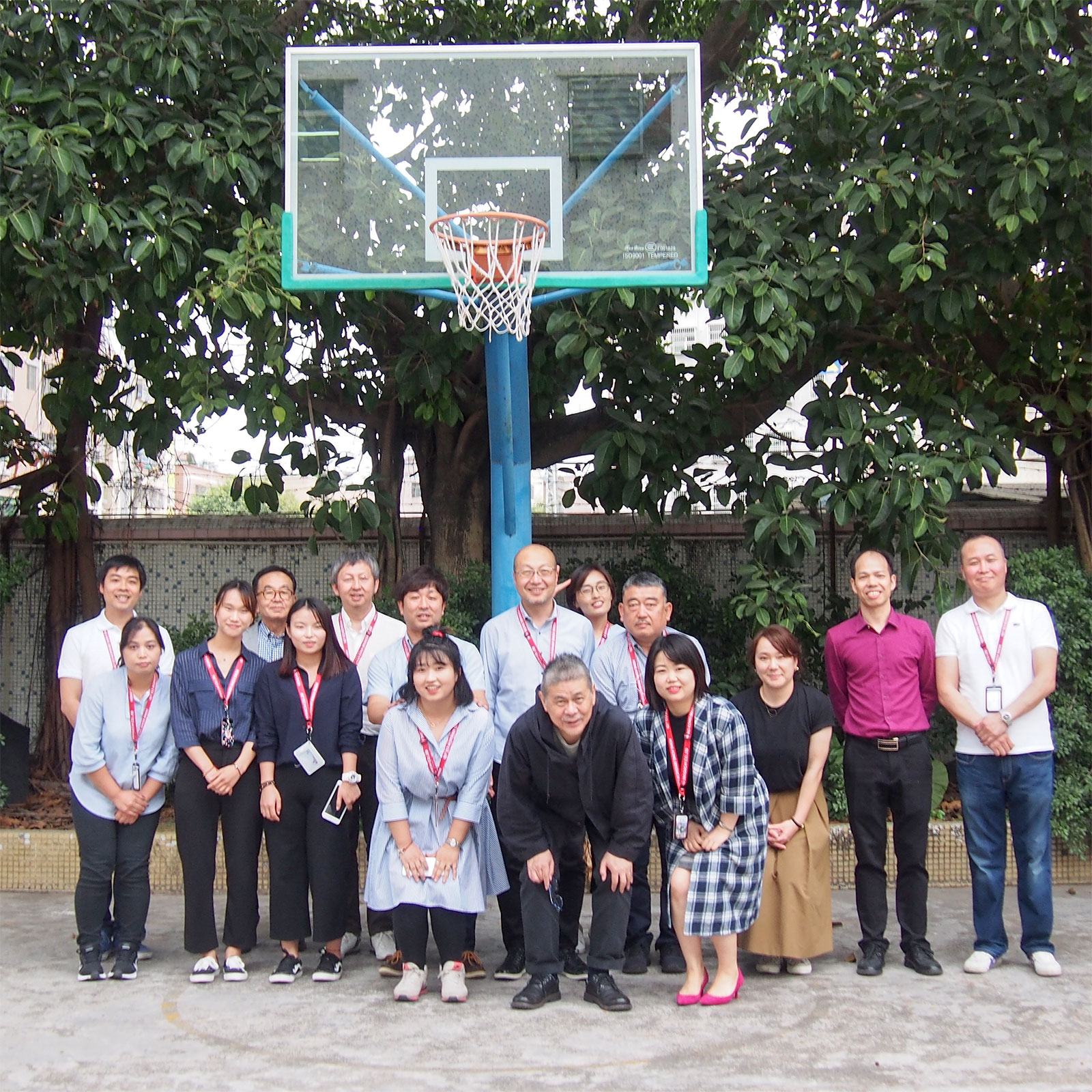
We took a group photo at the end of our visit.
Itoi: Seeing all the hard work you put into the production process makes us want to pay careful attention to what we ask for when we place an order. It’s very motivating.
While we were there, we were able to check out a sample of the new Drawer Pouch Blooming Nakanishi is making for us, as well as some of their suggestions. We can’t show it to you just yet, but Itoi was very delighted at what he saw.
Itoi: It’s not ready for final production quite yet, but it’s looking great so far.
We hope we’ll be able show it to you someday!
Thank you to Blooming Nakanishi and all the staff!
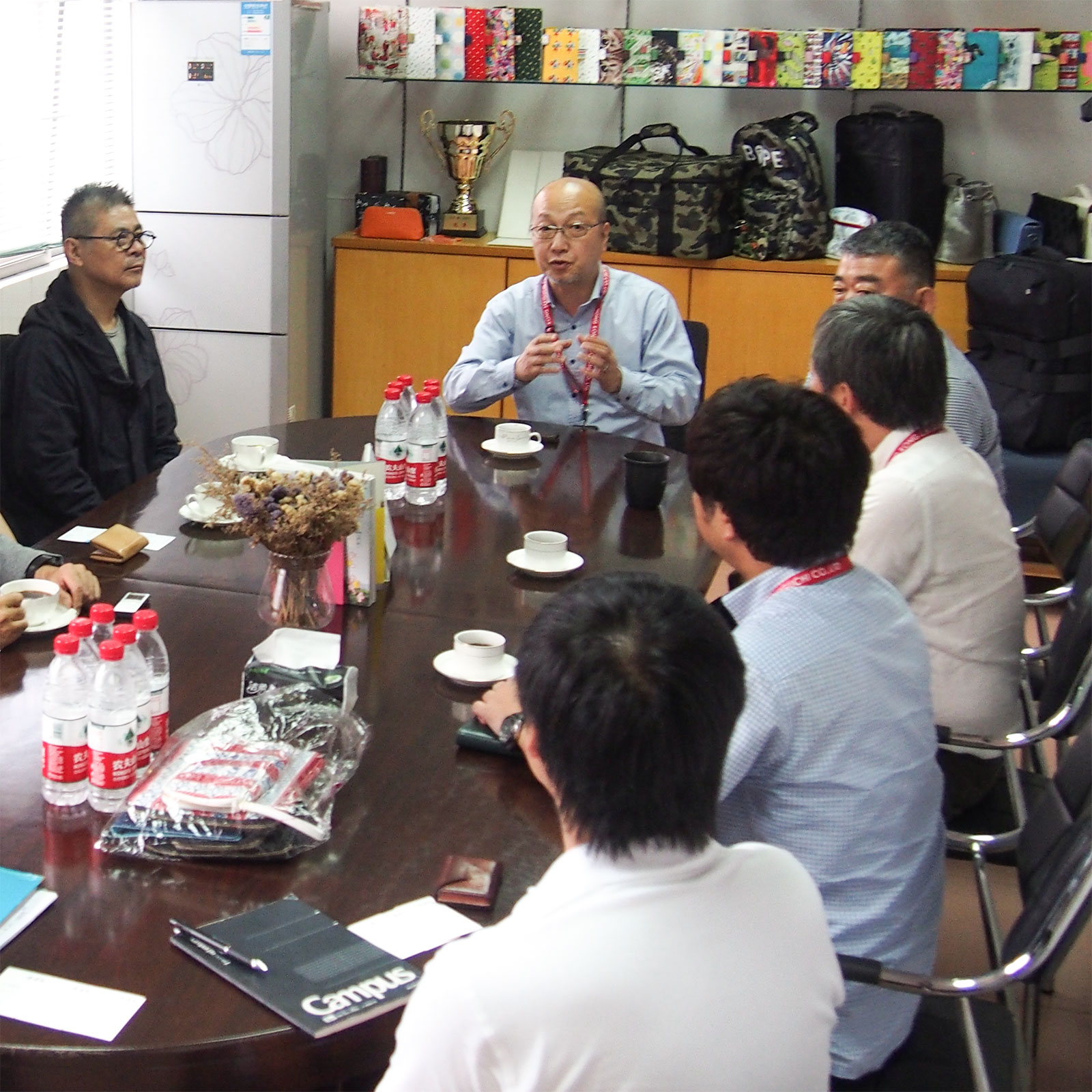
Blooming Nakanishi has a factory in Huizhou, China that handles all aspects of the Hobonichi Techo covers, from printing to assembly. We’ve worked with Blooming Nakanishi every year since 2014. For the 2019 lineup the factory created the Antique Handkerchief, Ryoji Arai, and Mother 2 covers.
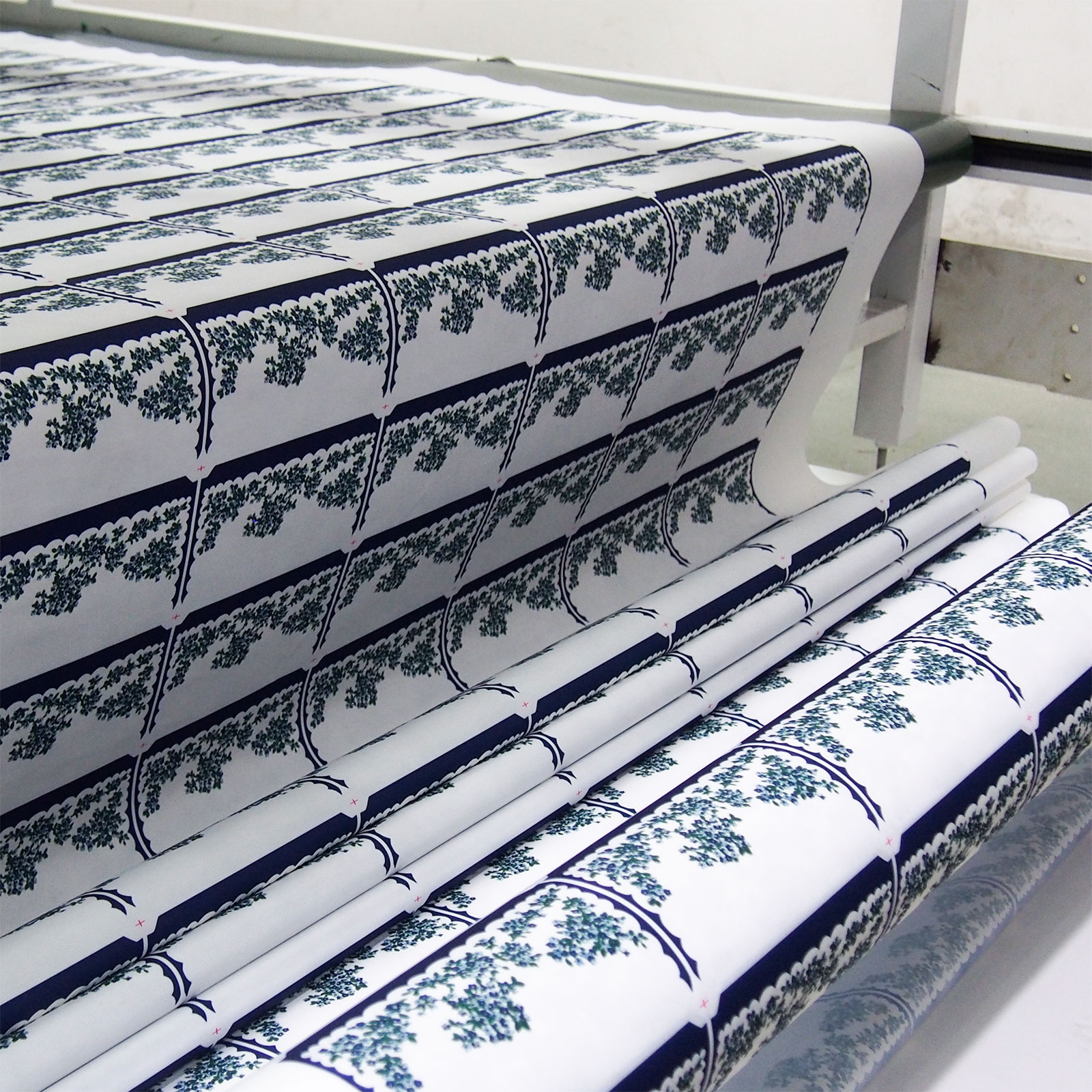
We’ve had Blooming Nakanishi create our print covers for years. Compared to paper, it’s a real challenge to print crisp designs onto cloth materials like the techo covers, so it was amazing to see the vibrant printed materials being processed at the factory! Their long history creating handkerchiefs means their polished printing techniques allow them to handle the artwork and photography on our cover designs, even when the colors require an especially delicate touch.
Itoi: I’m sure it’s hard to print on the coarse texture of the techo cover. We’re so grateful for the way you print such difficult designs as our pixelated Mother designs. The result looks effortless.
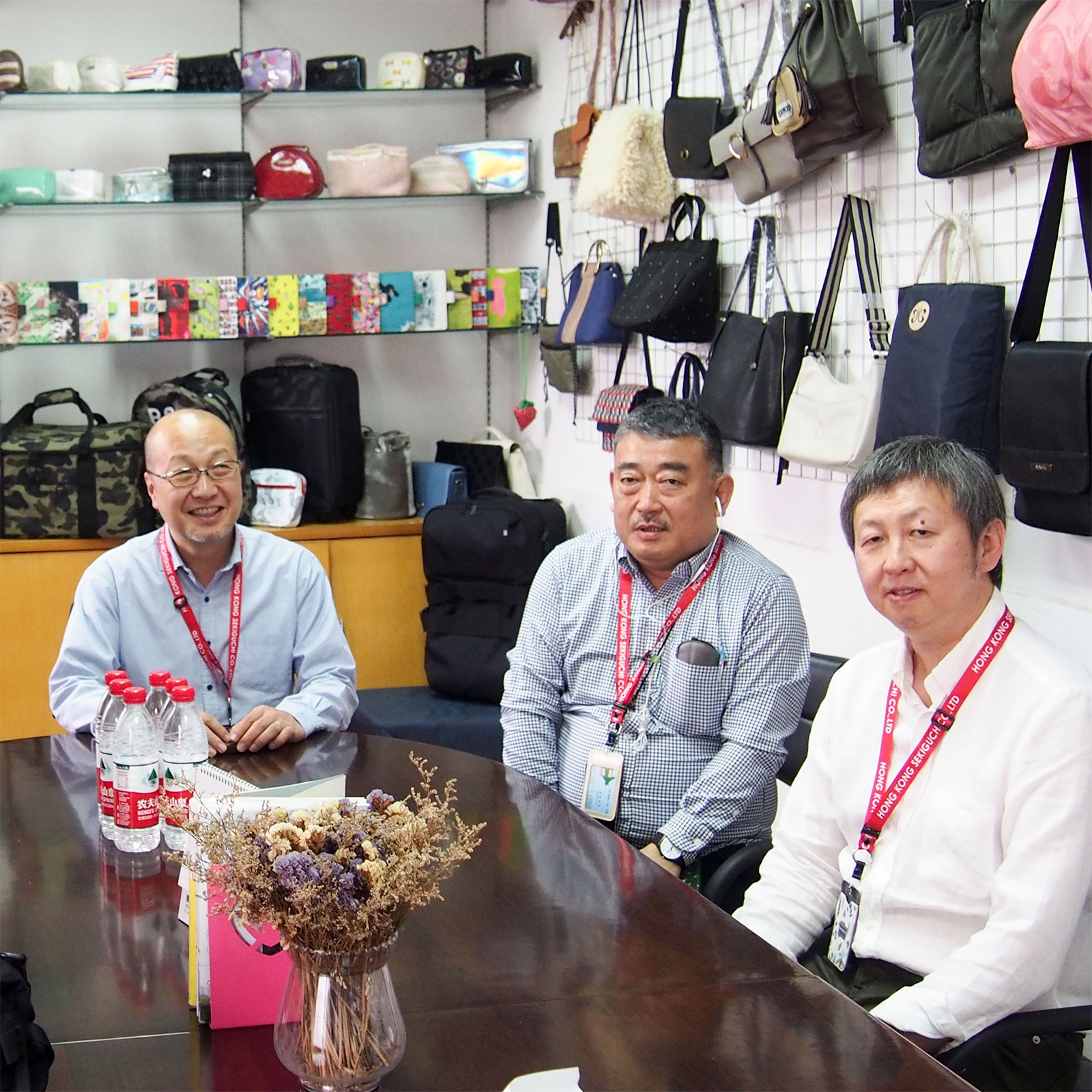
We were greeted by (left to right) Ina, Yoshida, and Kohno. They told us that the greatest struggle of our six years in business together was during the first year. We had always struggled through long processes of trial and error in order to get delicate colors to appear properly on our products. But everything got much easier when we started working with Blooming Nakanishi. By taking care of the printing in-house at the factory, the team was able to pinpoint issues with the printing process and keep an eye on improvements until everything was just right. By now they can tell just by looking what parts of a design will need extra attention.
Itoi: We’ve got a mutual sense of struggle and happiness we share with one another.
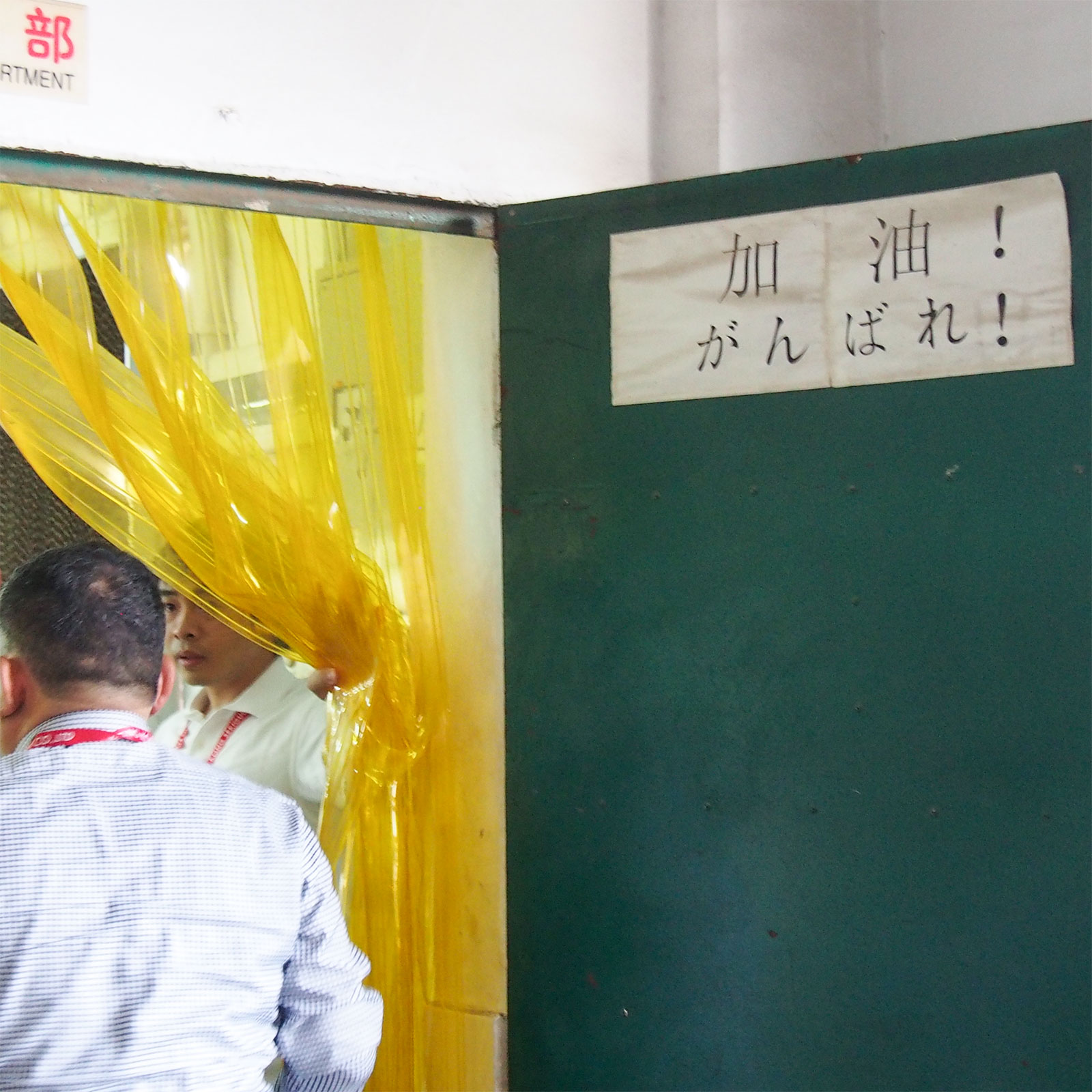
The door to the manufacturing area has an encouraging sign that reads “Do your best!” in both Chinese and Japanese. The Huizhou plant has workers who can speak Japanese, making it easy for the team to communicate with staff back in Japan if there are any issues.
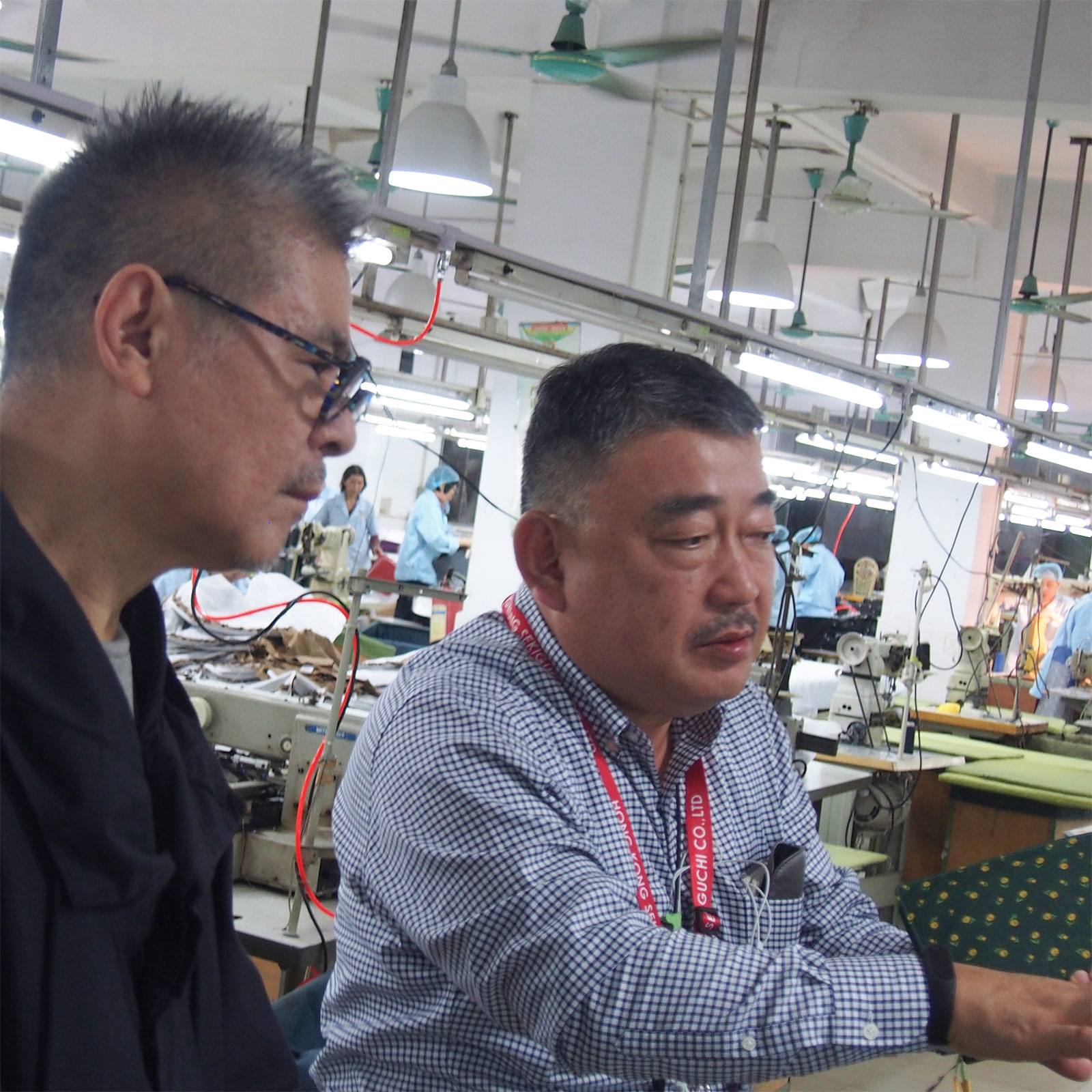
The crew showed us around the factory, which mainly makes Japanese-brand handbags. The color standards are quite high for Japanese brands, and Blooming Nakanishi carries that same attention to detail to all their production. Itoi’s visit took place in November, when the factory was busy manufacturing products for the upcoming spring.
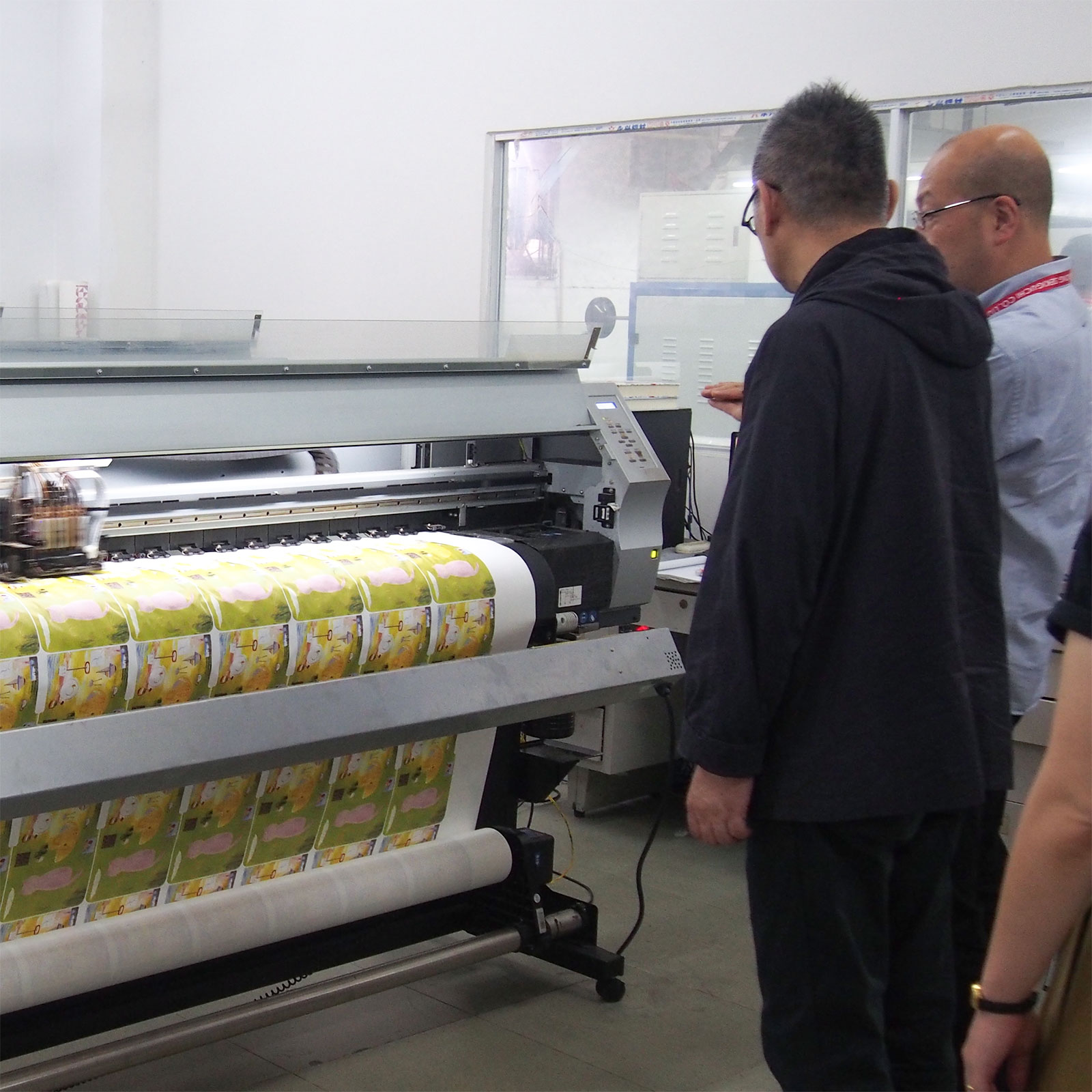
We got to see the giant printer operating within the plant. Here the machine is producing a reprint of the Ryoji Arai techo covers. The pattern is first printed onto paper and then transferred onto the cover material. The design looks rather yellow at this stage, but the colors are carefully calibrated in a way that will produce the correct color scheme in the final product. Inspections take place under natural lighting, fluorescent lights, and other lighting conditions to provide a controlled environment. This attention to detail for colors is one of the strengths of having a factory where everything is done in-house.
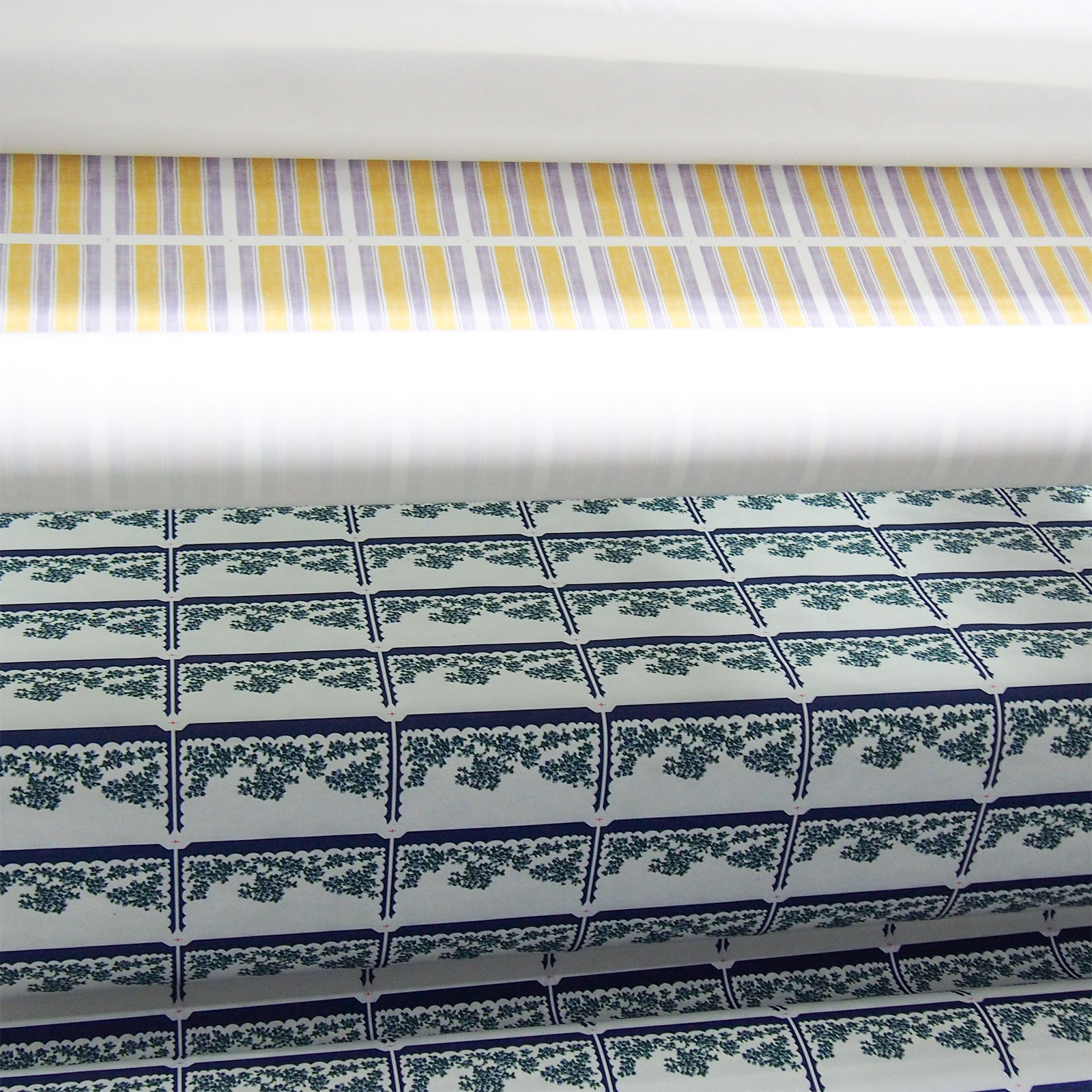
Here you can see the prints of the Antique Handkerchief - Souveneir Alaska cover being transferred from paper onto the cover material. The yellow and purple design at the top is the pattern on the pen holders, and the blue and green pattern on the bottom is from the outer back pocket of the cover. Patterns are printed tightly together to prevent unnecessary waste.
Itoi: Every step we’re seeing is still clearly done by hand. Not one step looks like someone’s waving a magic wand to make it appear.
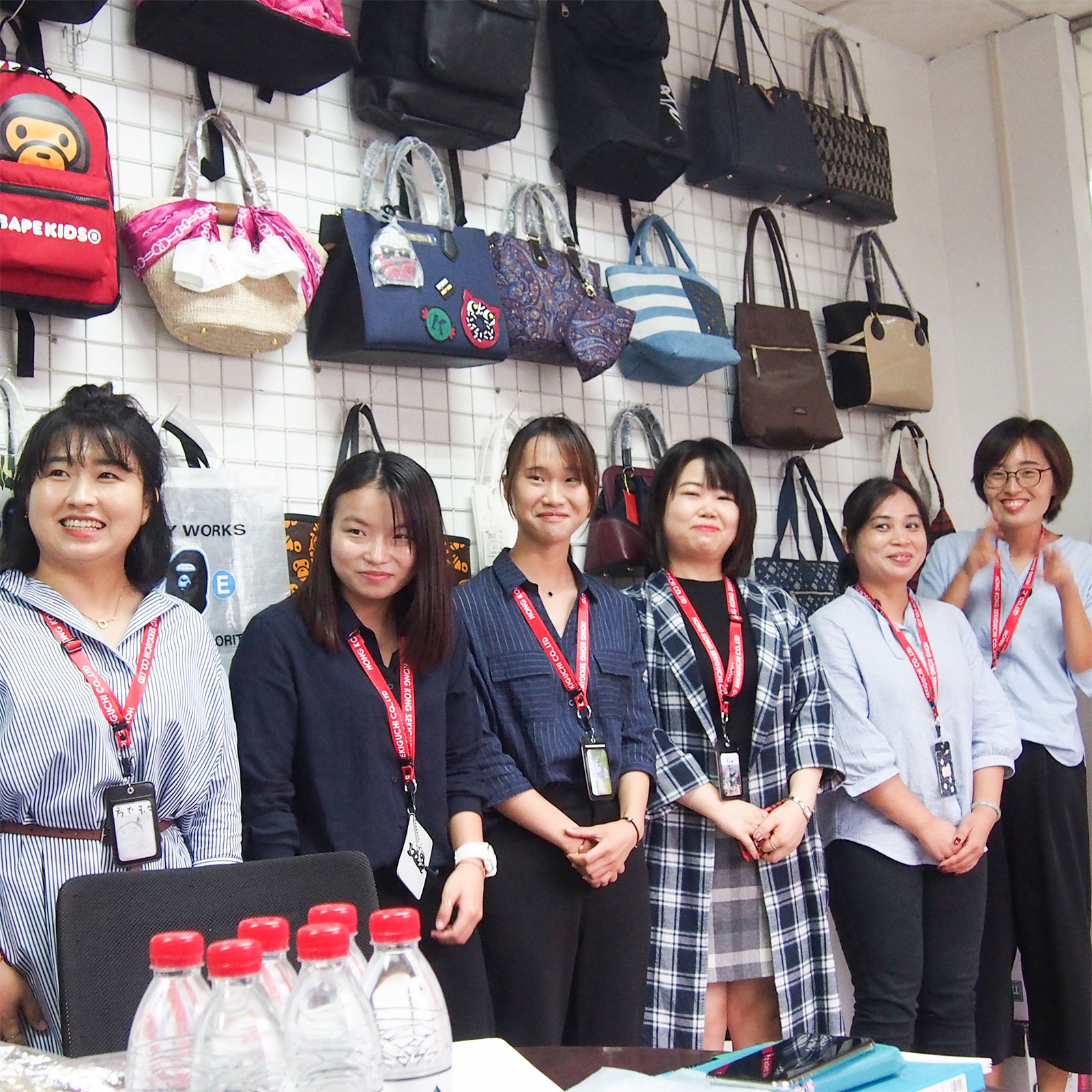
After the factory tour was over, the manufacturing team stopped by to say hello. Everyone got along quite well with each other, and there was a nice, calm aura to the workplace. Many of the workers are locals who have worked at the factory for a long time, giving them plenty of time to have honed their skills and create a consistent quality of products.
Itoi: This company seems like one where kids from the area would want to work when they grow up.
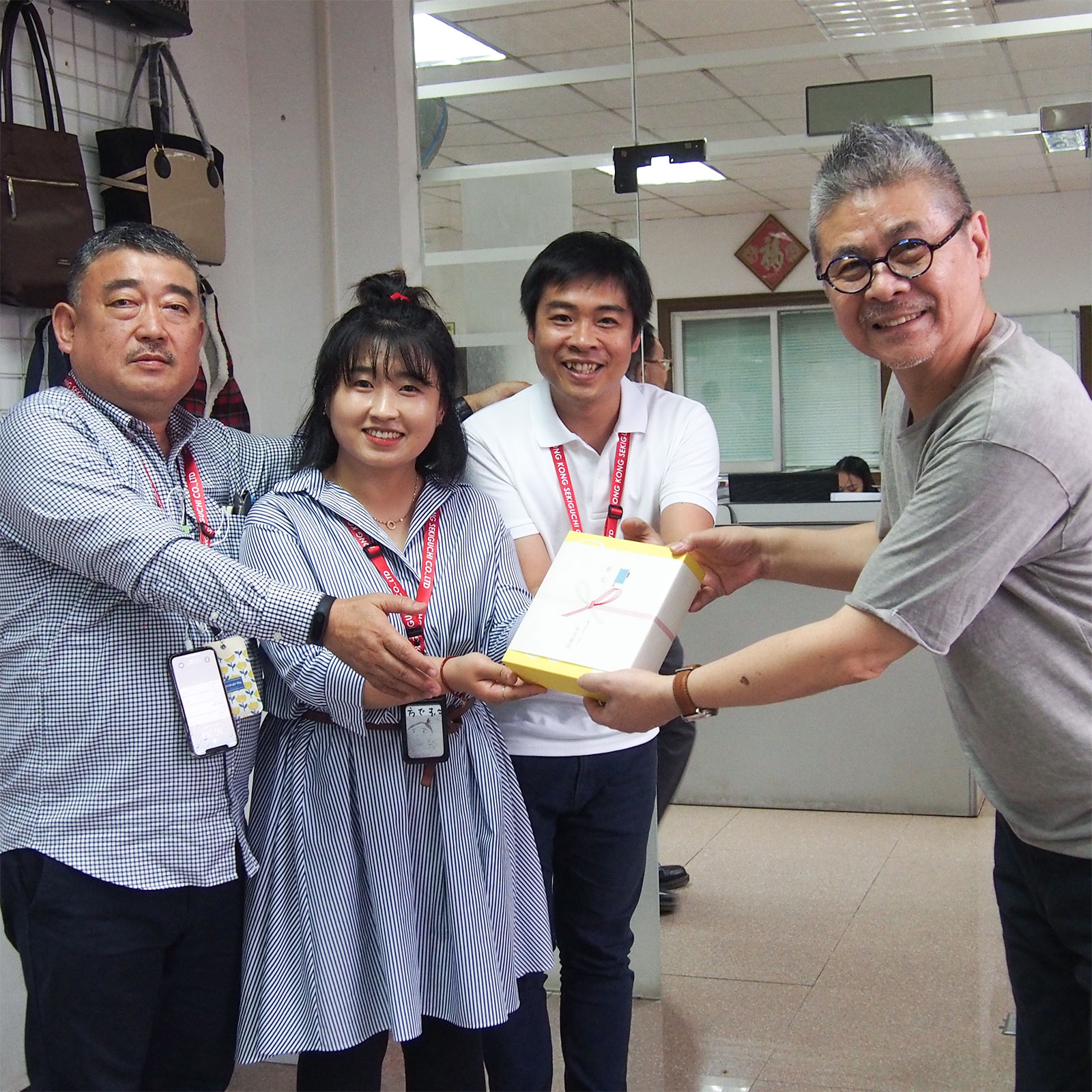
Itoi presented the thank-you gift of cookies to the factory crew.
Itoi: I feel like you’re all in a position to get frustrated at the demands we make about our products, but instead you’ve been gracious enough to stick around and accommodate us. We’re very grateful for you, and it’s your hard work that’s made the trust our customers have for us possible.
Ina: It’s been invigorating having you come visit us. The greater the challenges, the more we’re able to polish our skills.

We took a group photo at the end of our visit.
Itoi: Seeing all the hard work you put into the production process makes us want to pay careful attention to what we ask for when we place an order. It’s very motivating.
While we were there, we were able to check out a sample of the new Drawer Pouch Blooming Nakanishi is making for us, as well as some of their suggestions. We can’t show it to you just yet, but Itoi was very delighted at what he saw.
Itoi: It’s not ready for final production quite yet, but it’s looking great so far.
We hope we’ll be able show it to you someday!
Thank you to Blooming Nakanishi and all the staff!

Blooming Nakanishi has a factory in Huizhou, China that handles all aspects of the Hobonichi Techo covers, from printing to assembly. We’ve worked with Blooming Nakanishi every year since 2014. For the 2019 lineup the factory created the Antique Handkerchief, Ryoji Arai, and Mother 2 covers.

We’ve had Blooming Nakanishi create our print covers for years. Compared to paper, it’s a real challenge to print crisp designs onto cloth materials like the techo covers, so it was amazing to see the vibrant printed materials being processed at the factory! Their long history creating handkerchiefs means their polished printing techniques allow them to handle the artwork and photography on our cover designs, even when the colors require an especially delicate touch.
Itoi: I’m sure it’s hard to print on the coarse texture of the techo cover. We’re so grateful for the way you print such difficult designs as our pixelated Mother designs. The result looks effortless.

We were greeted by (left to right) Ina, Yoshida, and Kohno. They told us that the greatest struggle of our six years in business together was during the first year. We had always struggled through long processes of trial and error in order to get delicate colors to appear properly on our products. But everything got much easier when we started working with Blooming Nakanishi. By taking care of the printing in-house at the factory, the team was able to pinpoint issues with the printing process and keep an eye on improvements until everything was just right. By now they can tell just by looking what parts of a design will need extra attention.
Itoi: We’ve got a mutual sense of struggle and happiness we share with one another.

The door to the manufacturing area has an encouraging sign that reads “Do your best!” in both Chinese and Japanese. The Huizhou plant has workers who can speak Japanese, making it easy for the team to communicate with staff back in Japan if there are any issues.

The crew showed us around the factory, which mainly makes Japanese-brand handbags. The color standards are quite high for Japanese brands, and Blooming Nakanishi carries that same attention to detail to all their production. Itoi’s visit took place in November, when the factory was busy manufacturing products for the upcoming spring.

We got to see the giant printer operating within the plant. Here the machine is producing a reprint of the Ryoji Arai techo covers. The pattern is first printed onto paper and then transferred onto the cover material. The design looks rather yellow at this stage, but the colors are carefully calibrated in a way that will produce the correct color scheme in the final product. Inspections take place under natural lighting, fluorescent lights, and other lighting conditions to provide a controlled environment. This attention to detail for colors is one of the strengths of having a factory where everything is done in-house.

Here you can see the prints of the Antique Handkerchief - Souveneir Alaska cover being transferred from paper onto the cover material. The yellow and purple design at the top is the pattern on the pen holders, and the blue and green pattern on the bottom is from the outer back pocket of the cover. Patterns are printed tightly together to prevent unnecessary waste.
Itoi: Every step we’re seeing is still clearly done by hand. Not one step looks like someone’s waving a magic wand to make it appear.

After the factory tour was over, the manufacturing team stopped by to say hello. Everyone got along quite well with each other, and there was a nice, calm aura to the workplace. Many of the workers are locals who have worked at the factory for a long time, giving them plenty of time to have honed their skills and create a consistent quality of products.
Itoi: This company seems like one where kids from the area would want to work when they grow up.

Itoi presented the thank-you gift of cookies to the factory crew.
Itoi: I feel like you’re all in a position to get frustrated at the demands we make about our products, but instead you’ve been gracious enough to stick around and accommodate us. We’re very grateful for you, and it’s your hard work that’s made the trust our customers have for us possible.
Ina: It’s been invigorating having you come visit us. The greater the challenges, the more we’re able to polish our skills.

We took a group photo at the end of our visit.
Itoi: Seeing all the hard work you put into the production process makes us want to pay careful attention to what we ask for when we place an order. It’s very motivating.
While we were there, we were able to check out a sample of the new Drawer Pouch Blooming Nakanishi is making for us, as well as some of their suggestions. We can’t show it to you just yet, but Itoi was very delighted at what he saw.
Itoi: It’s not ready for final production quite yet, but it’s looking great so far.
We hope we’ll be able show it to you someday!
Thank you to Blooming Nakanishi and all the staff!
We’ve got a mutual sense of struggle and happiness we share with one another.
Blooming Nakanishi
Founded in 1879 as an import shop for gloves, western umbrellas, handkerchiefs, and more. Produces original textiles such as handkerchiefs and home textile goods. The factory in Huizhou functions as an OEM to manufacture Japanese name-brand bags. Using the skills acquired from printing intricate designs onto handkerchiefs, the company is able to do everything from high-quality prints to sewing assembly.
